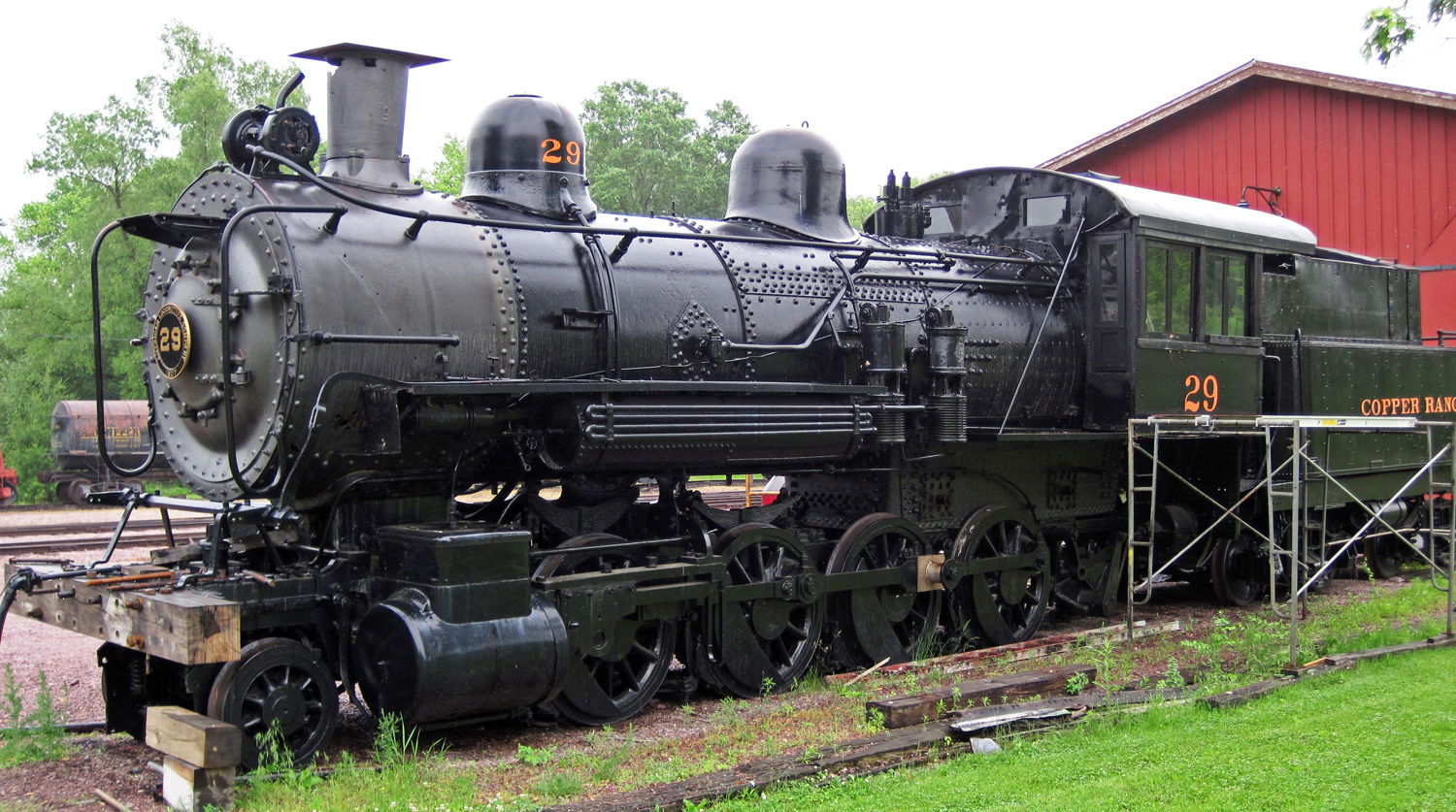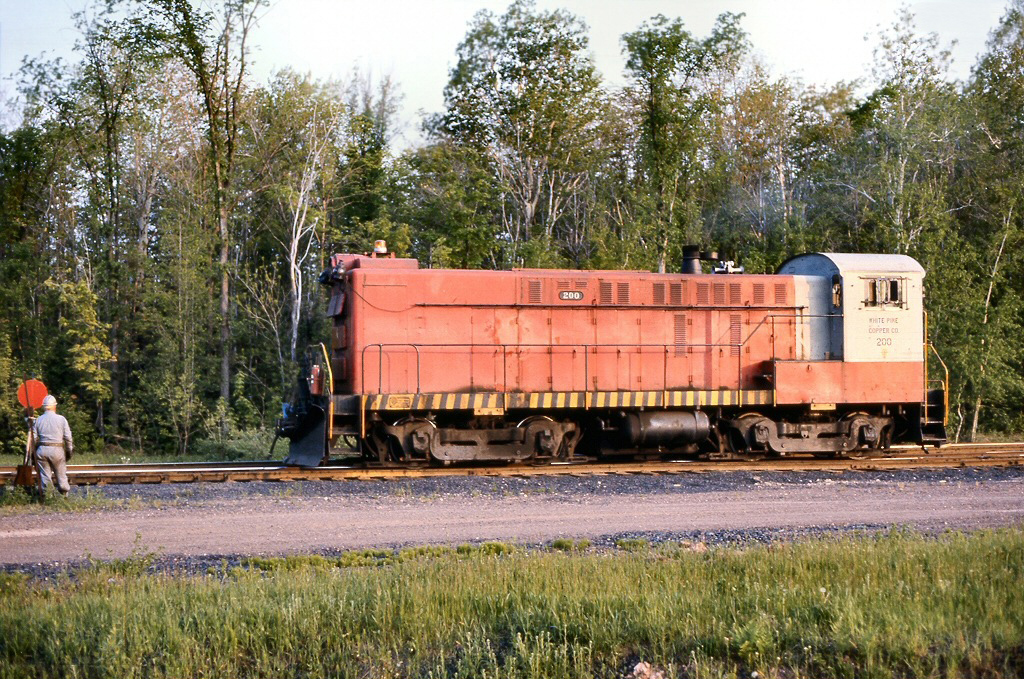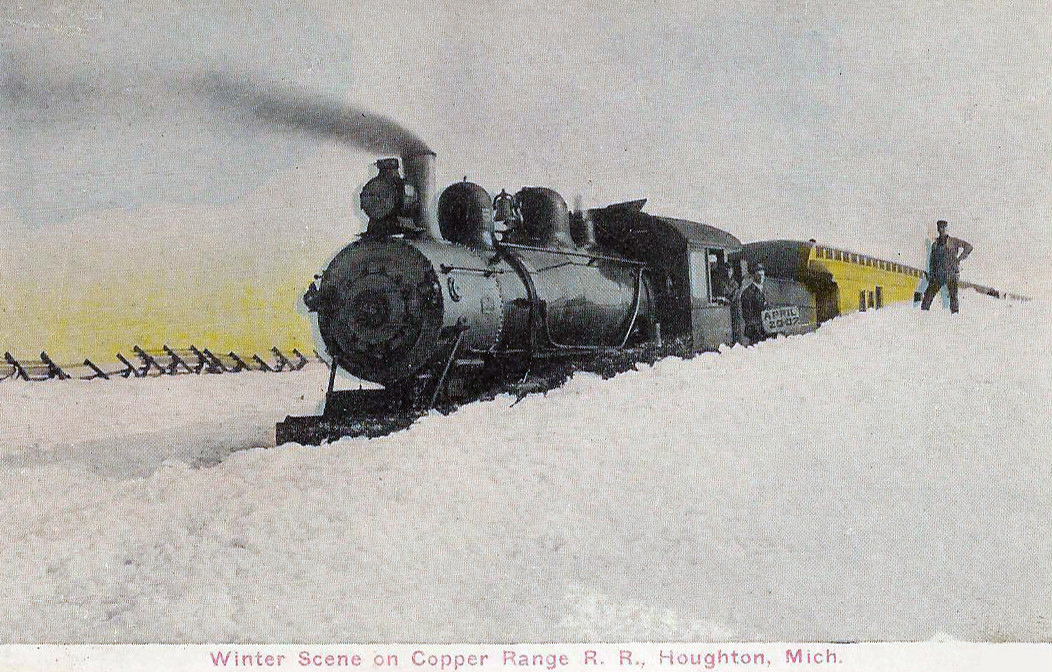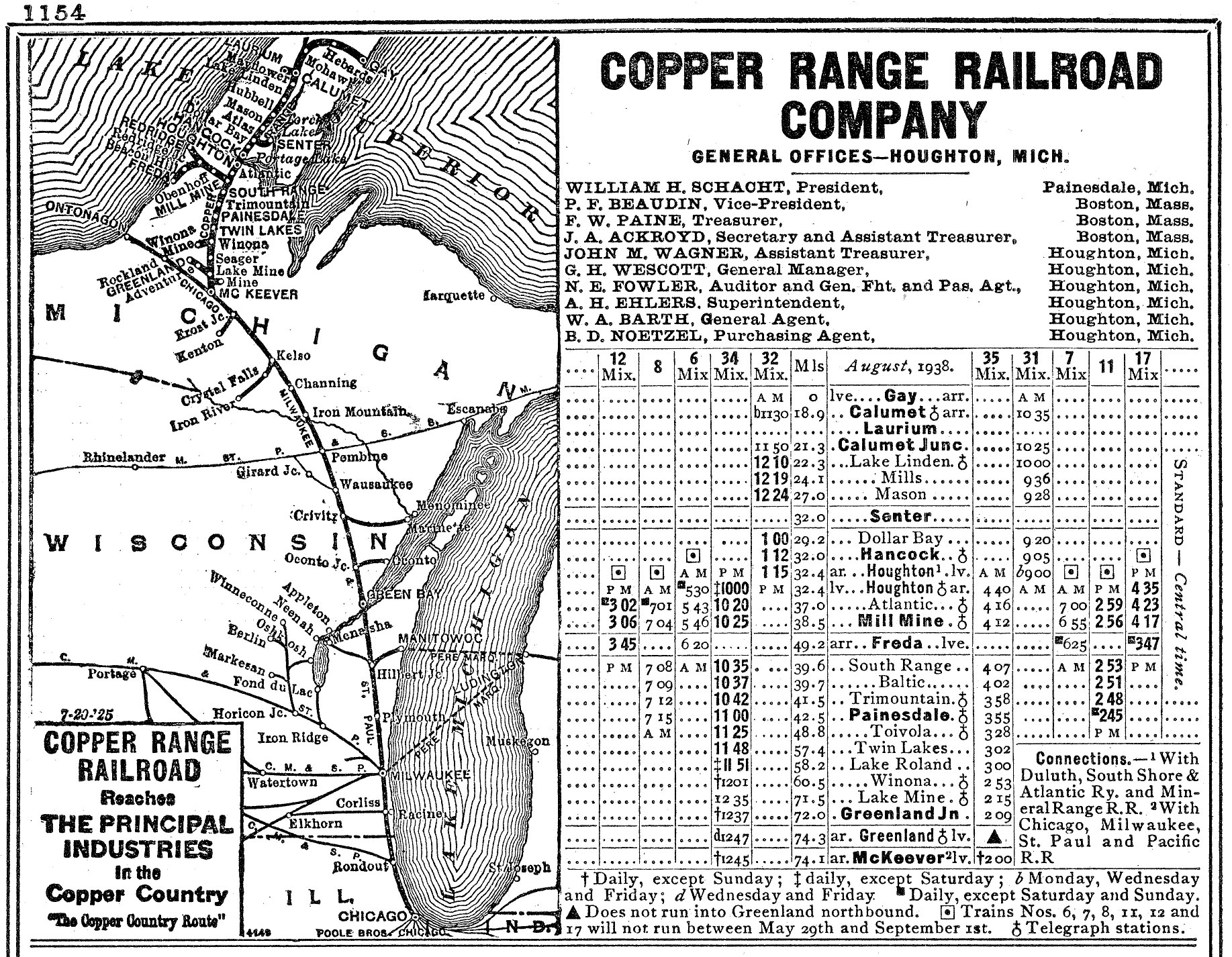Copper Range Railroad: Serving The Keweenaw Peninsula
Last revised: September 3, 2024
By: Adam Burns
The Copper Range Railroad (reporting marks, COPR) was a classic shortline serving the Keweenaw
Peninsula of Michigan.
It was owned and operated by the Copper Range Company to serve several mines in the region with a connection to the Chicago, Milwaukee, St. Paul & Pacific (the Milwaukee Road) at McKeever as well as the Soo farther north.
At its peak the system was nearly 75 miles in length with several spurs branching from its main line between McKeever to as far north as Gay.
The railroad was built with a twofold purpose. Primarily, to effectively transfer copper from the mines to the smelters, and subsequently, transport the refined metal to market. Additionally, it was crucial in bringing in laborers and supplies to the remote mining towns of the Keweenaw Peninsula.
The earliest history of railroads serving the region dated to the 1870s via a narrow-gauge line although the Copper Range itself was not officially created for another 15 years following.
After World War II the system slowly declined and cutback as mines played out and closed.
By the early 1970s virtually all major traffic had disappeared and the railroad was officially abandoned with tracks scrapped soon afterward. Today, sections of the original line are now a rail/trail.
Formation
The history of the Copper Range Railroad was chartered in March of 1899 to serve its parent's extensive mining network around the Portage Lake region of the Keweenaw Peninsula.
Since 1873 a line had already been operating between Hancock and Calumet, the narrow-gauge, 14-mile long Mineral Range Railroad. Construction of the new route began that spring of 1899 and by December it was opened between Houghton and Winona, 28.9 miles.
The railroad also by then had established its primary yard and offices in Houghton, which also included a roundhouse and all major maintenance facilities.
This town sat at about the half-way point once the system was completed and also connected with the Mineral Range, a setup that lasted for many years as it later became part of the Duluth, South Shore & Atlantic Railway (DSS&A) which itself was purchased by the Soo Line.
At A Glance
McKeever (Milwaukee Road) Houghton (Soo Line and Mineral Range Railroad) | |
By around 1913 the Copper Range had been completed in terms of both its 74.1-mile main line between McKeever and Gay as well as its many branches.
Mine Branches
In all, the railroad had about six branches of some size that included:
- Calumet to Mayflower.
- Dollar Bay to Senter.
- Winona to the Winona Mine.
- Lake Mine to Greenland.
- A short spur to Mine (just north of McKeever).
- The major branch that split from Mill Mine and reached Redridge to the west.
- Finally, a short southward spur to Freda.
These secondary routes connected to a wide array of copper mines.
However, the Copper Range also served coal mines around South Range, lumber mills (notable was the Boniface-Gorman Lumber Company at the northern end of the system in Gay), stamp mills, and the Michigan Smelting Company near Houghton.
It's somewhat amazing the amount of mines the railroad served given that the peninsula is only 70+ miles in length.
 Copper Range Railroad 2-8-0 #29 (C-2) preserved at the Mid-Continent Railway Museum in North Freedom, Wisconsin. The Consolidation was built by Alco's Schenectady Works in 1907. James St. John photo.
Copper Range Railroad 2-8-0 #29 (C-2) preserved at the Mid-Continent Railway Museum in North Freedom, Wisconsin. The Consolidation was built by Alco's Schenectady Works in 1907. James St. John photo.Motive Power
Typical power for the Copper Range Railroad during the steam era including the 2-8-0 Consolidation, its workhorse.
Most of these locomotives were built by the American Locomotive Company's Schenectady, New York facility that ranged in size from 96 to 100 tons; other wheel arrangements the company owned included 2-6-0 Moguls, 4-6-0 Ten Wheelers, and 4-4-0 Americans.
After 1910 the Copper Range reached trackage rights agreements with the Milwaukee Road to extend its passenger services east to Channing and west to Ontonagon along the banks of Lake Superior.
In general, the railroad did not invest heavily in passenger operations due to the lightly populated area although it did offer daily service for many years, especially early on (at one time it even hosted an observation car on its trains).
Later, as demand decline the only way to catch a train was via a mixed freight. This practice was finally cancelled after 1950.
Bankruptcy
As early as the summer of 1927 mines along the Copper Range Railroad began to close, the first of which was the Seneca Mine.
The company's only bankruptcy followed on March 26, 1935 due to the ongoing depression although it was able to exit receivership a few years later on July 1, 1938.
At this time it had just nine steam locomotives still in operation, nearly all of which were its 2-8-0s. Diesels began arriving in April of 1947, two Baldwin-built DS-4-4-1000 switchers #100-101.
Interestingly, Copper Range management insisted that the new locomotives be "painted in a scheme identical to that illustrated in the Baldwin's catalog."
Thus, they sported a red on the hood which trailed away into a light grey with yellow trim here and there. A few years later during July of 1951 the company picked up one more, a Baldwin S-12, #200.
System Map and Timetable (1925)
This essentially completed its diesel roster, as steam had been completely retired by 1947 with the purchase of the two DS-4-4-1000s.
Final Years
The decline and eventual abandonment of the Copper Range Railroad was predicated on multiple factors. One significant factor was the rise of automotive and trucking industries.
Road transport not only presented a more flexible alternative but also required less maintenance. Additionally, as copper mining began to wane in the Keweenaw Peninsula, the railroad experienced a steady decrease in traffic and revenue.
 White Pine Copper Mine S-12 #200, ex-Copper Range Railroad #200 built by Baldwin in 1951, enters a switch at White Pine, Michigan in June of 1976. Rob Kitchen photo.
White Pine Copper Mine S-12 #200, ex-Copper Range Railroad #200 built by Baldwin in 1951, enters a switch at White Pine, Michigan in June of 1976. Rob Kitchen photo.Decline for the Copper Range Railroad continued through the 1950s and 1960s as more mines closed. By 1969 only 52.8 miles of the main line remained between Lake Linden (22.3 miles south of the original northern terminus at Gay) and McKeever with the only branch line still in use served the Winona Mine.
On August 24, 1972 permission was granted from the Interstate Commerce Commission (ICC) for total abandonment and the last train ran that year on November 3.
By the spring of 1974 the entire railroad had been pulled up and scrapped. Ironically, today, one could hardly tell trains ever ran through the Keweenaw Peninsula as the Soo Line and Milwaukee Road branches were also abandoned long ago.
Legacy
While the railroad ceased operations in the late 20th century, it certainly left behind an indelible mark. Its influence in the region is seen through the vestiges of mining towns and industries it once served. The towns of Houghton and Hancock, for instance, owe much of their development to the railroad.
Interestingly, the story of the Copper Range Railroad does not end with its abandonment. Post-cessation, portions of the railroad's route were repurposed into public recreational trails.
The Copper Country Trail National Byway, for example, which winds through Michigan's Copper Country, offers a scenic outdoor experience for residents and visitors.
In conclusion, the Copper Range Railroad, much like its sister, the Mineral Range Railroad, remains a symbol of America's industrial past. Both played pivotal roles in shaping not only the Keweenaw Peninsula but also the wider industrial landscape of Northern Michigan.
The remnants of this once-mighty railroad stand as silent reminders of a bygone era, offering insights into a time when rails carried the hopes and dreams of many, much like the copper they hauled.
Contents
Recent Articles
-
Rio Grande 2-8-2 Locomotives (K-37): Specs, Roster, Photos
Apr 15, 25 12:57 PM
Rio Grande's Class K-37 Mikes were itsdge steamers to enter service in the late 1920s. Today, all but two survive. -
Rio Grande 2-8-2 Locomotives (K-36): Specs, Roster, Photos
Apr 15, 25 11:09 AM
The Rio Grande's K-36 2-8-2s were its last new Mikados purchased for narrow-gauge use. Today, all but one survives. -
Rio Grande 2-8-2 Locomotives (Class K-28): Specs, Roster, Photos
Apr 14, 25 10:24 PM
Rio Grande's Class K-28 Mikados were its newest narrow-gauge steam locomotives since the Mudhens of the early 1900s. Today, three survive.




